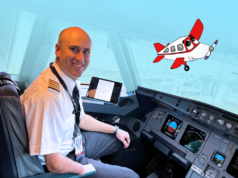Avoiding a threat requires being aware that a threat exists. At what stage of situational awareness are you operating? In Part One (Aero Crew News, October 2018) we learned how our minds work in situations of extreme stress, what the OODA LOOP is and how to keep from being paralyzed in the “decide” phase. When you’re aware of potential threats and make plans to avoid or escape before necessary, you’ve already won the battle. Situational awareness is something most of us think we have, but rarely do. People in law enforcement and the military have situational awareness 24/7 because their training teaches them that their lives depend upon it daily. The difference is, they know it and most of us never think our day will require it. Self Defense for Flight Crews – Part Two includes some fun and effective daily situational awareness exercises you can immediately start using in your daily routine. You’ll be safer, more confident and more prepared to handle whatever little surprises life may decide to throw at you.
Whether you’re in the air or on the ground, at work or on your day off, there are five levels of situational awareness at which you operate. By choice or by default, we’re always in one of these five levels and switch among them depending on our circumstances.
As you rise to higher belt levels in the martial arts, you realize that the physical techniques and skill sets are just tools to be used by our mindset. The mindset of a good fighter rests in recognizing and practicing these things:
- Recognizing that threats do exist.
- Ignorance or denial of this is dangerous.
- Apathy, denial and complacency are deadly.
- Learn to “trust your gut.”
- Discipline yourself to practice situational awareness.
LEVELS OF AWARENESS
- TUNED OUT = Crossing a busy street against a red light texting on your cell phone.
- RELAXED AWARENESS = Waiting to cross the busy street until the light changes. Your cell phone is in your pocket.
- FOCUSED AWARENESS = The light changes to green. You look for cars and cross the street.
- HIGH ALERT = The light changes, you look for cars, someone runs the red light and you step back up onto the curb to avoid getting hit.
- COMATOSE = You’re texting on your cell phone while crossing the street against the red light. Oncoming cars are honking, slamming on the brakes and careening around you. You look up and freeze like a deer in the headlights
The best place to be in daily life is in a state of relaxed awareness. If you practice it, it will become an automatic normal state of being. The best way to win a fight is to avoid it in the first place by always being situationally aware.
SITUATIONAL AWARENESS
DAILY EXERCISES:
A: If you’re a flight attendant, start paying attention to the different heights, body types, perceived strength levels and genders of the passengers boarding your aircraft relative to your own. Visualize red dots where the targets are on each of them. Mentally note which of your tools would be most effective in relation to the differences. Anyone can do this anywhere. Boarding your passengers is a convenient and relevant time. Flight attendants greet and mentally assess millions of passengers daily. Trust your instincts and communicate any concerns to your crew. If you’re wrong, you’ll have to put up with some teasing. Should you be right, you will have everyone’s respect and gratitude, and you’ll all be alive to enjoy it.
B: When you enter a room, make a mental note of how many windows are in the room and where they are. How many doors are there? Where are they located? Which ones are entry and exits versus closets or storage rooms, potentially for hiding? How many people are in the room? What is the mix of men and women, adults and children? Close your eyes a few minutes later and see if you get it right. You can add more details once you get good at this.
C: Seat yourself at tables in restaurants and other venues to give you a clear view of entrances and exits as well as access to a good escape route should it be needed. It’s a habit many law enforcement officers employ without even thinking about it.
D: Be aware of some of the warning signs that you’re about to be attacked. These include:
- Another invading your personal space, especially when there are only a few people around.
- Someone asking you for the time, change, to use your cell phone, etc. This tactic is often used in kidnappings.
- Someone walking towards and focusing on you, personally, especially a stranger and most especially if they have their hands behind their back.
- Observe coordinated motion. You stop, they stop. You cross the street, they cross the street. You can use reflective surfaces such as windows to monitor this.
- Glances. Someone is constantly looking around to see if anyone’s watching.
- Someone in front of you is constantly shifting their weight.
- Herding. Someone trying to lure or maneuver you into an isolated place. This can apply when you’re in a car, too. Be aware of bumping, crowding, etc.
- Never flash money or expensive jewelry.
Maintain awareness levels two, three or four in the following:
Parking lots and parking structures. This includes airports, shopping malls, event parking lots, etc. If you can, try to park under a light and close to the areas from which most people will be coming and going. Remote, unlit areas are always more attractive to would-be assailants. If you come out to find a van ( particularly one without windows or someone in it) parked next to you, enter from the opposite car door and then lock yours, or go back to a safe place and get someone to walk with you, or wait. Sliding the van doors open when you pause next to your car door and dragging you into the van is a common tactic for abductions. When you’re driving, another ploy to get you out of your car is to either ram it from behind or stop abruptly in front of you, causing you to run into them. NEVER allow yourself to be dragged into a vehicle. Your chances of surviving once they have you in their car are drastically reduced.

Going to and from your hotel room. Always be aware of people punching in one floor on the elevator but getting off on yours. Be mindful of violations of your personal space. Be prepared for someone to open their door just as you walk by and try to drag you in. If you think someone is following you, pass your room and go back to the front desk if possible. Never try to open your door and go inside if someone is in close proximity. Besides, you don’t want them to know which room you’re in if they’re setting off your inner warning bells. If possible, always try to walk with another flight crew member or friend.
Now, while your mind is still in a creative, critical thinking mode, start sharing other potential scenarios you may have experienced with your fellow flight crew members. We learn from each other and it helps us to build that movie in our minds before we have to confront a real situation and get trapped in the “decide” portion of the OODA Loop. Decide before it happens. It’s too late to decide when it happens. Aero Crew News is a great place to have a discussion or add suggestions. Part three of Self Defense for Flight Crews will deal with the ATTACK and Neutralize the Threat portion of ACA. We’ll address with the physical aspects of Tools and Targets – how, when and where to use them effectively, simply and in some cases with extreme prejudice, when your life hangs in the balance. We’ll also cover a few basics of defense against knives and guns. Until then, never stop exploring those movies in your mind. Safe journeys, my friends. ACN
























































